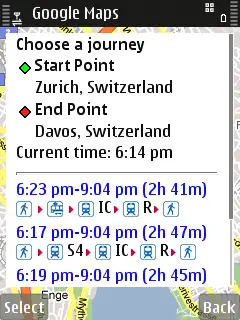You may recall that one of the 50 ADC Round 1 Winners was for an application called PedNav, essentially mapping systems for urban settings. If you’re a pedestrian wanting to get from Point A to Point B, what are the chances you’ll want to follow the rules of One-Way Streets, Exit Ramps and such?
Very little… which explains why PedNav was such a simple, articulate and useful little solution that city dwellers could easily see becoming a consistent resource via Android enabled Phones. Obviously, judges of ADC Round 1 agreed as PedNav won one of the Top 50 prizes in the competition and continued on to Round 2.
As we know, winners received $25,000 for further development of their applications. But the folks at RouteMe2 Technologies, makers of PedNav, have to feel somewhat slighted by the award. Why? Because Google itself now allows users to get WALKING DIRECTIONS.

Ouch, that burns. And you can bet that the Google Maps API will include walking directions support so that other developers can use Walking Directions in their own applications… like ones that will be found on the Android platform. At first glance, it seems like this would leave PedNav more or less defeated before the competition begins. Does it not?
But walking directions is only the START of overlapping competition between Google and application developers. How about public transportation, for example? Google already has Public Transit directions available for BlackBerry’s and within the past week has launched support for Public Transit Directions for Windows Mobile and Symbian S60 devices… you can download it here.

Don’t get us wrong… its an AWESOME little application and capability. The point is, Google has stepped on a few toes with wireless carriers throughout this whole Android thing and it was only a matter of time before they start stepping on the territory of their own platform’s developers.
You could argue that google has been into mapping and directions for a LONG time – and you’d be right – but is this just the start? How long will it be before Google sees neat applications and capabilities by 3rd party apps on Android and creates their own version, distributes in bulk and provides an API for broader reach?
Google’s mission is to organize the world’s information. But, as we’ve seen with Knoll and now Android, there is a fine line between finding, collecting and organizing existing information from 3rd parties (like Google Search) and actually producing information yourself and organizing it along with all the 3rd parties.
We understand that you can’t please everyone – Google can’t afford to look out for the feelings and interest of every little developer when it has much bigger tasks at hand (which a billion dollar enterprise should have). However, where is the line drawn? How affected will its partners and developers become? How many lines will Google cross?
We’ve seen the unsuspecting rise and fall of many great companies and brands. While Google is enjoying outrageous success and the end seems nowhere on the horizon… could this foreshadow the cause of their eventual demise – even if decades down the road? Is Google trying to do too much at the expense of too many?
What do YOU think?








Walking directions are something provided by most personal navigation devices, especially those meant to be handheld/mobile. Expect to see google do a whole lot more.
There’s competing, and then there’s competing.
Your example of walking and transit directions are logical “line extensions” of Google’s existing driving directions, akin to Procter & Gamble developing Tide-brand “stain sticks” to extend their existing line of laundry detergent. I don’t view this so much as “overlapping competition between Google and application developers” as application developers who consciously decided to get in the path of an oncoming train.
Now, take an app like Android Scan. That would be much more of a stretch to consider as a logical extension of something Google already has — the closest thing would be Google Shopping (the old Froogle). If Google decided to build their own Scan equivalent, *that* might well qualify as competing with their developers.
@ Mark
I LOVE your example of getting “in the path of an oncoming train”. Not only is it funny… even if the pun was unintended… but its right on the money.
I agree that anyone could see Google making these “Line Extensions”. The AndroidScan comparison might seem like a stretch now… but over time, I think its the type of thing that will happen at some point. Android and Google’s other ventures are creating so many relationships on every side of many industries that they won’t be able to prevent/avoid stepping on toes in some major ways.
Just ask Verizon. I’m sure there will be others… it would be interesting to see if the folks at PedNav could weigh in.
on word: duh. if you don’t think google hasn’t been planning walking directions across their entire maps line of interfaces, you are a fool. if you are banking your strategy on this one feature, you are a fool.
this was somewhat covered in the legal stuff we all agreed to when we submitted:
“You acknowledge and understand that Google and/or members of the Open Handset Alliance may independently develop applications that may be similar to or identical to your Entry in terms of theme, idea, function, or in other respects. You agree that you will not be entitled to any rights in, or compensation in connection with, any such similar or identical applications and/or ideas. You acknowledge that you have submitted your Entry voluntarily and not in confidence or in trust.”
http://code.google.com/android/adc-submit/tandc.html
the interesting, ambiguous word here being “independently.” and with software patents recently starting to fade away (see coverage on /.), this opens the door even wider.
I always thought PedNav uses Google Transit APIs in the background, so, basically, what so surprising for Google adding in the their own functionality to mobile Google Maps – it’s logical and very much expected. With regards to walking directions – Google Maps have walking directions for ages, they just brought it to mobile – also very much expected. I guess the power of PedNav is about creating activities and then providing those directions and transport recommendations only when they’re really needed as well as answering on “am I likely to get there in time?” type of queries.
Google and Nokia were already working on optimizing their maps and routes for walking since the WMC in Barcelona. I think Nokia has this implemented already too, so did they steal it as well then?
If Enkin wins, all you need to do is flash you phone’s camera around, and you’ll figure out on your own how to get there…. I’m talking about walking of course.
But having those Public Transit and Walking directions are magnificent.
I call foul on this article being anything more than baiting.
First of all, Google quite simply GAVE PedNav developers $25,000 for their hard work. The competition was designed to advertise and showcase their OS, for which they paid good money to honest people.
Secondly, the waking directions in question are only currently available on their website, which only coincidentally is viewable on Android, but no one in their right mind would bypass the internal application for that. This would not make it a “competing” product.
Thirdly, Google is not using any privileged information or access that is otherwise hidden from general developers to make their “product” better than the “competition” (Internet Explorer, anyone?).
Lastly, pedestrian navigation is as proprietary a concept as the WHILE loop. Anyone claiming to have exclusivity to the concept would be well advised to think again.